» posted on Wednesday, October 2nd, 2013 by Linda Lou Burton
Less Traveled By
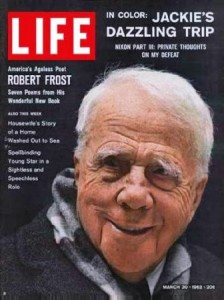 Linda Burton posting from Concord, New Hampshire – Two men, born on different coasts, in different centuries. What do they have in common? Robert Lee Frost (1874-1963) began life in San Francisco; Kenneth Lauren Burns (b 1953) in Brooklyn. But each chose New Hampshire as a place to live, and work, and grow; New Hampshire put its stamp on them. And from New Hampshire, they reflected the world back to us; interpreted in ways both simple and profound. Robert Frost was a poet; in his lifetime garnering more than forty honorary degrees, four Pulitzer Prizes, and one Congressional Medal of Honor. Critic Randall Jarrell said of him “no other poet has written so well about the actions of ordinary men.” Biographer Lawrance Thompson wrote that Frost’s poems are “charged with an intensity of cherishing.” And perhaps the greatest accolade is this – Frost’s poems are part of the curriculum in every class on American literature. How many young souls found their life purpose bolstered by the line “I took the road less traveled by”? Did
Linda Burton posting from Concord, New Hampshire – Two men, born on different coasts, in different centuries. What do they have in common? Robert Lee Frost (1874-1963) began life in San Francisco; Kenneth Lauren Burns (b 1953) in Brooklyn. But each chose New Hampshire as a place to live, and work, and grow; New Hampshire put its stamp on them. And from New Hampshire, they reflected the world back to us; interpreted in ways both simple and profound. Robert Frost was a poet; in his lifetime garnering more than forty honorary degrees, four Pulitzer Prizes, and one Congressional Medal of Honor. Critic Randall Jarrell said of him “no other poet has written so well about the actions of ordinary men.” Biographer Lawrance Thompson wrote that Frost’s poems are “charged with an intensity of cherishing.” And perhaps the greatest accolade is this – Frost’s poems are part of the curriculum in every class on American literature. How many young souls found their life purpose bolstered by the line “I took the road less traveled by”? Did  filmmaker Ken Burns come across that line when he was a young student? I don’t know; but Burns has certainly lived his life and gone about his work in ways unlike any other. His documentary films have brought him (so far) twenty-five honorary degrees, twelve Emmy Awards, two Oscar nominations, and a Lifetime Achievement Award. From his first documentary in 1981 (Brooklyn Bridge), Burns’ films have mesmerized the public. David Zurawik wrote “Burns not only turned millions…onto history with his films, he showed us a new way of looking at our collective past.” Burns’ father-in-law said his work was “an attempt to make people long gone come back alive.” Besides New Hampshire, what else touched the lives of these men? I decided to dig a little deeper.
filmmaker Ken Burns come across that line when he was a young student? I don’t know; but Burns has certainly lived his life and gone about his work in ways unlike any other. His documentary films have brought him (so far) twenty-five honorary degrees, twelve Emmy Awards, two Oscar nominations, and a Lifetime Achievement Award. From his first documentary in 1981 (Brooklyn Bridge), Burns’ films have mesmerized the public. David Zurawik wrote “Burns not only turned millions…onto history with his films, he showed us a new way of looking at our collective past.” Burns’ father-in-law said his work was “an attempt to make people long gone come back alive.” Besides New Hampshire, what else touched the lives of these men? I decided to dig a little deeper.
I spent a delightful afternoon at the Robert Frost Farm in Derry, New Hampshire, where Randee Martin and Alex Fowler filled my ear with story after story of the man, and his family; 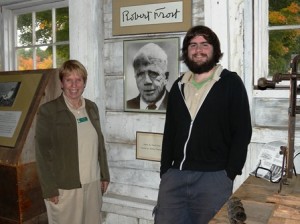 pointing to the very ground he plowed as a farmer, and the stones in the fence back in the woods (Mending Wall). Frost didn’t last long as a farmer, I learned, he preferred teaching, and writing, although he identified closely with the rhythm of the farmer’s life.
pointing to the very ground he plowed as a farmer, and the stones in the fence back in the woods (Mending Wall). Frost didn’t last long as a farmer, I learned, he preferred teaching, and writing, although he identified closely with the rhythm of the farmer’s life.
How did Robert Frost, born in San Francisco, get to New Hampshire? That California birthplace was a quirk; Frost’s father William Prescott Frost Jr was born in New Hampshire and studied at Harvard; his adventuring spirit led him to San Francisco, where he worked as a journalist, and became 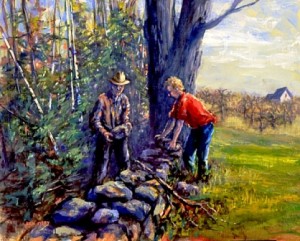 editor of the San Francisco Evening Bulletin. Robert was eleven when his father died of tuberculosis and the family returned to New England; William had dictated that he was to be buried there. After the funeral, Robert’s mother Isabelle began teaching in Salem Depot, New Hampshire; thus began Robert’s rural lifestyle.
editor of the San Francisco Evening Bulletin. Robert was eleven when his father died of tuberculosis and the family returned to New England; William had dictated that he was to be buried there. After the funeral, Robert’s mother Isabelle began teaching in Salem Depot, New Hampshire; thus began Robert’s rural lifestyle.
You can read the chronology of Robert Frost’s life here, http://robertfrostfarm.org/chronology.html; it lists where he lived and where he worked in his 89 years, his marriage and the birth (and death) of his children; it tells of his publications, and his awards. It was 1924 when he won the first of  four Pulitzer Prizes for the book New Hampshire: A Poem with Notes and Grace Notes. He won additional Pulitzers for Collected Poems in 1931, A Further Range in 1937, and A Witness Tree in 1943.Vermont claims Frost too; he lived and taught there at various times and in fact, is buried there, in the Old Bennington Cemetery, along with his wife and the four children who preceded him in death. Frost’s first books were published when he lived in England; he also studied and taught at Harvard and he taught at the University of Michigan in Ann Arbor. How did he view the importance of New Hampshire in his life? In 1938, as part of the Federal Writers’ Project, he wrote:
four Pulitzer Prizes for the book New Hampshire: A Poem with Notes and Grace Notes. He won additional Pulitzers for Collected Poems in 1931, A Further Range in 1937, and A Witness Tree in 1943.Vermont claims Frost too; he lived and taught there at various times and in fact, is buried there, in the Old Bennington Cemetery, along with his wife and the four children who preceded him in death. Frost’s first books were published when he lived in England; he also studied and taught at Harvard and he taught at the University of Michigan in Ann Arbor. How did he view the importance of New Hampshire in his life? In 1938, as part of the Federal Writers’ Project, he wrote:
 Not a poem, I believe, in all my six books…but has something in it of New Hampshire. Nearly half of my poems were written in New Hampshire…I lived…in Salem, Derry, Plymouth, and Franconia…from my tenth to my forth-fifth year….Most of my time out of it I lived…on the edge of New Hampshire, where my walks and vacations could be in New Hampshire. My first teaching was…in the southern part of Salem….Four of my children were born in Derry….My father was born in Kingston. So you see…it has been New Hampshire with me all the way.
Not a poem, I believe, in all my six books…but has something in it of New Hampshire. Nearly half of my poems were written in New Hampshire…I lived…in Salem, Derry, Plymouth, and Franconia…from my tenth to my forth-fifth year….Most of my time out of it I lived…on the edge of New Hampshire, where my walks and vacations could be in New Hampshire. My first teaching was…in the southern part of Salem….Four of my children were born in Derry….My father was born in Kingston. So you see…it has been New Hampshire with me all the way.
Robert Kyle Burns was a graduate student in cultural anthropology at Columbia University when son Ken was born in 1953. Ken’s academic family moved frequently; they lived in France, they lived in Maryland, and they lived in Michigan, where Robert Burns taught at the University of Michigan in Ann Arbor; Ken’s mother Lyla died as a result of breast cancer 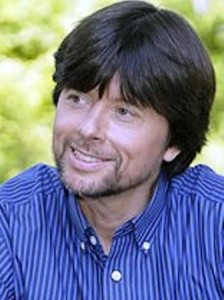 when he was eleven. Ken was a well-read child, preferring history to fiction; when he received an 8 mm movie camera for his 17th birthday, he used it to shoot a documentary about an Ann Arbor factory. He left Michigan after high school, and headed for Amherst, Massachusetts, and a newly founded alternative school – Hampshire College – where he studied under photographers Jerome Liebling and Elaine Mayes.
when he was eleven. Ken was a well-read child, preferring history to fiction; when he received an 8 mm movie camera for his 17th birthday, he used it to shoot a documentary about an Ann Arbor factory. He left Michigan after high school, and headed for Amherst, Massachusetts, and a newly founded alternative school – Hampshire College – where he studied under photographers Jerome Liebling and Elaine Mayes.
It’s been a fast-moving journey since he graduated from college in 1975. In 1976, he moved to Walpole, New Hampshire, where he and Roger Sherman, Buddy Squires, and Larry Hott founded Florentine Films. The company is still headquartered there; each of the four works independently under the Florentine Films  name; Florentine Films often works with other organizations to produce films. In 1977 Ken began work on adapting David McCullough’s book The Great Bridge, about the construction of the Brooklyn Bridge; his feature documentary Brooklyn Bridge was released in 1981 and ran on PBS; it earned an Academy Award nomination for Best Documentary; Ken was 28 that year. Ken then went on to make several other award-winning films, including The Shakers: Hands to Work, Hearts to God; The Statue of Liberty , also nominated for an Oscar; Huey Long , the story of the turbulent Southern dictator; The Congress: The History and Promise of Representative Government; Thomas Hart Benton , a portrait of the regionalist artist; and Empire of the Air: The Men Who Made Radio .
name; Florentine Films often works with other organizations to produce films. In 1977 Ken began work on adapting David McCullough’s book The Great Bridge, about the construction of the Brooklyn Bridge; his feature documentary Brooklyn Bridge was released in 1981 and ran on PBS; it earned an Academy Award nomination for Best Documentary; Ken was 28 that year. Ken then went on to make several other award-winning films, including The Shakers: Hands to Work, Hearts to God; The Statue of Liberty , also nominated for an Oscar; Huey Long , the story of the turbulent Southern dictator; The Congress: The History and Promise of Representative Government; Thomas Hart Benton , a portrait of the regionalist artist; and Empire of the Air: The Men Who Made Radio .
 Were you one of the 40 million people who followed The Civil War series in 1990? It was the highest-rated series in the history of American Public Television at the time; Ken was director, producer, co-writer, chief cinematographer, music director, and executive producer. He did the same for the series Baseball in 1994, which attracted 45 million viewers. The West was released in 1996; Lewis and Clark: The Journey of the Corps of Discovery in 1997; Frank Lloyd Wright in 1998; The Story of Elizabeth Cady Stanton and Susan B Anthony in 1999. Historian Stephen Ambrose said of his films “More Americans get their history from Ken Burns than any other source.”
Were you one of the 40 million people who followed The Civil War series in 1990? It was the highest-rated series in the history of American Public Television at the time; Ken was director, producer, co-writer, chief cinematographer, music director, and executive producer. He did the same for the series Baseball in 1994, which attracted 45 million viewers. The West was released in 1996; Lewis and Clark: The Journey of the Corps of Discovery in 1997; Frank Lloyd Wright in 1998; The Story of Elizabeth Cady Stanton and Susan B Anthony in 1999. Historian Stephen Ambrose said of his films “More Americans get their history from Ken Burns than any other source.”
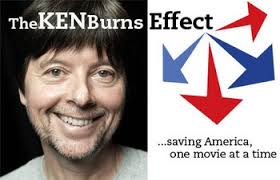 What makes his films so watchable? Many have told stories of the Civil War, and baseball. What is there about a Ken Burns film that holds so many viewers in its grip? Some give credit to a technique called The Ken Burns Effect; it’s his signature style of cutting rapidly from one still picture to another in a fluid, linear fashion, then pepping up the visuals with first-hand narration gleaned from contemporary writings, and spoken by top stage and screen actors. He also frequently uses simple musical leitmotifs; causing one critic to note, “One of the most memorable things about The Civil War was its haunting, repeated violin melody, whose thin, yearning notes seemed somehow to sum up all the pathos of that great struggle.”
What makes his films so watchable? Many have told stories of the Civil War, and baseball. What is there about a Ken Burns film that holds so many viewers in its grip? Some give credit to a technique called The Ken Burns Effect; it’s his signature style of cutting rapidly from one still picture to another in a fluid, linear fashion, then pepping up the visuals with first-hand narration gleaned from contemporary writings, and spoken by top stage and screen actors. He also frequently uses simple musical leitmotifs; causing one critic to note, “One of the most memorable things about The Civil War was its haunting, repeated violin melody, whose thin, yearning notes seemed somehow to sum up all the pathos of that great struggle.”
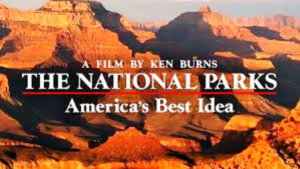 Go to the Florentine Films site http://www.florentinefilms.com/ffpages/F-frameset.html for a complete listing of Ken Burns films; you’ve probably recently seen The National Parks, and The Dust Bowl; watch for The Roosevelts, and Vietnam, in the works. Aged 60 now, he doesn’t show signs of stopping. I didn’t visit Walpole, although a volunteer at the Vermont State Information Center bent my ear for a while telling about his daughter’s work with Ken on several films during her student days. “Does he live in Vermont?” I’d asked then. “Oh no,” was the answer, “he lives in New Hampshire. But that’s just across the river there.”
Go to the Florentine Films site http://www.florentinefilms.com/ffpages/F-frameset.html for a complete listing of Ken Burns films; you’ve probably recently seen The National Parks, and The Dust Bowl; watch for The Roosevelts, and Vietnam, in the works. Aged 60 now, he doesn’t show signs of stopping. I didn’t visit Walpole, although a volunteer at the Vermont State Information Center bent my ear for a while telling about his daughter’s work with Ken on several films during her student days. “Does he live in Vermont?” I’d asked then. “Oh no,” was the answer, “he lives in New Hampshire. But that’s just across the river there.”
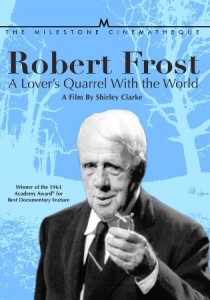 So what connections, other than their New Hampshire residence, did I find? A few things caught my attention – both had well-educated parents and both lost a parent when they were eleven. Both went to school in Massachusetts; both lived in Europe for a time; both, oddly enough, lived in Ann Arbor with connections to the University of Michigan – Robert Frost taught there; Ken Burns’ father taught there. Both had ordinary jobs in their early days; Robert delivered newspapers and worked in a shoe factory; Ken sold records in a music store. Both first attempted what became their life’s work in high school – Robert wrote his first poem; Ken made
So what connections, other than their New Hampshire residence, did I find? A few things caught my attention – both had well-educated parents and both lost a parent when they were eleven. Both went to school in Massachusetts; both lived in Europe for a time; both, oddly enough, lived in Ann Arbor with connections to the University of Michigan – Robert Frost taught there; Ken Burns’ father taught there. Both had ordinary jobs in their early days; Robert delivered newspapers and worked in a shoe factory; Ken sold records in a music store. Both first attempted what became their life’s work in high school – Robert wrote his first poem; Ken made  that 8 mm movie about a factory. And both developed techniques for their work that were beyond the norm; Frost’s work was considered “at the crossroads” with regard to traditional form, idiomatic language, and ordinary subject matter. What came to be known as the “Ken Burns Effect” was a dramatic and surprising new style.
that 8 mm movie about a factory. And both developed techniques for their work that were beyond the norm; Frost’s work was considered “at the crossroads” with regard to traditional form, idiomatic language, and ordinary subject matter. What came to be known as the “Ken Burns Effect” was a dramatic and surprising new style.
Did the environment of New Hampshire, where individualism is prized, lead these two men to take the road less traveled? Or just allow it? I cannot say if either is true, but I do know this: New Hampshire is fiercely proud to claim them.
Robert Frost Farm, Derry, New Hampshire, 603-432-3091, http://robertfrostfarm.org/
The Frost Place, Franconia, New Hampshire, 603-823-5510, http://frostplace.org/
Florentine Films, Walpole, New Hampshire, http://www.florentinefilms.com/
Ken Burns America, http://www.pbs.org/kenburns/
I shall be telling this with a sigh, somewhere, ages and ages hence. Two roads diverged in a wood and I – I took the one less traveled by, and that has made all the difference. The Road Not Taken, Robert Frost, 1920
